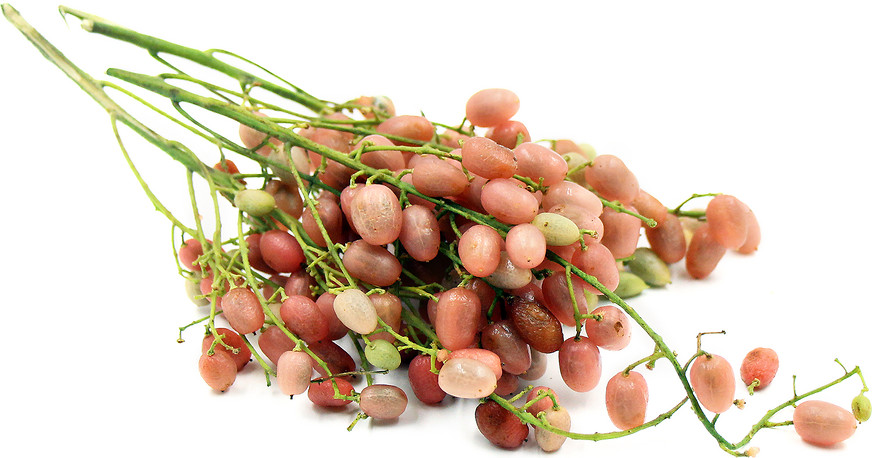


Pink Wampee
Estimated Inventory, lb : 0
Description/Taste
Pink Wampee berries are tiny grape-sized fruits that have a rounded ovate or slightly conical shape. These fruits typically measure about 2.5 centimeters long and 2 centimeters wide. Their translucent skin is light pink or pink-red with a glossy texture. This skin is mostly smooth but may appear slightly shriveled. Their juicy and gelatinous flesh is divided into segments each containing a shiny blue-green seed. Pink Wampee berries have a sweet and slightly citrusy flavor with a mildly resinous and kumquat-like aftertaste created by the tiny oil glands under their skin. The berry's flavor also contains notes of black licorice, fennel, coriander, and coffee.
Seasons/Availability
Pink Wampee berries are available from summer to fall.
Current Facts
Pink Wampee berries are known botanically as Clausena excavata and belong to the Rutaceae family along with lemons, grapefruit, and kumquats. They grow on trees with branches described by botanist J.D. Hooker as being as thick as a crow’s quill, indicating their slender nature. These trees typically reach heights of 2 to 6.5 meters and produce cascades of tiny white flowers that transform into the Pink Wampee berries. When crushed the tree’s leaves release a curry-like aroma. The Pink Wampee is referred to as Hollowed Clausena and Pink Lime berry in English and Cherek Hitam, Chemama, and Kemantu Hitam in Malaysian. Pink Wampee trees are used to make axe handles, in perfumery for their essential oils, and as both an ornamental and edible plant.
Nutritional Value
Pink Wampees leaves, bark, and roots exhibit anti-inflammatory effects. Their berries are rich in antioxidants that help reduce oxidative stress and bolster the immune system with their high vitamin C content. Immature sun-dried berries and root slices are used to treat bronchitis and alleviate symptoms of cough and other respiratory issues. Herbal teas made from the leaves are commonly used to reduce fever. Pink Wampees are incorporated into folk medicine to treat a wide range of health issues including tooth decay, postpartum concerns, headaches, dyspepsia, intestinal worms, coughs, chicken lice, malaria, and fever. They are also recognized for their properties as a tonic, diuretic, and astringent.
Applications
Pink Wampee berries can be eaten fresh out of hand when peeled and fully ripe. They may be used to make fruit juices, wine, marinades, or salad dressings. In Southeast Asia they are bottled in a fermented carbonated beverage similar to champagne. Pink Wampee berries may be tossed into fruit bowls with mangoes, passion fruit, pineapples, oranges, and dragon fruit. They're often incorporated in desserts like sorbet, popsicles, and ice creams or serve as a topping for cakes and pastries. Pink Wampee berries are preserved in jams, gelatins, or turned into a filling for pies. They are complemented by the flavors of cinnamon, nutmeg, star anise, mint, chocolate, kumquats, lemon, citrus rind, apples, bananas, grapes, and peaches. Pink Wampee berries can be stored in the refrigerator for up to a week.
Ethnic/Cultural Info
Wampee berries are featured in Gui Hai Yu Heng Zhi, a work by the renowned Chinese poet and scholar Fan Chengda. This was a geographic and cultural text written during the Southern Song Dynasty. The book roughly translates to Records of the Land and Customs of Guizhou and provides detailed observations about the Guangxi and Guangdong regions in southern China. It has a particular focus on the customs, geography, flora, and fauna of these areas including the Wampee tree and their berries. He notes that Wampee berries resemble small jujubes in appearance. The text also includes vivid comparisons to other fruits known in the region, describing the Wampee berries as similar to a goat droppings fruit, a woody lotus fruit, and a gumi fruit with flesh resembling grains of rice.
Geography/History
Pink Wampee berries are native to Southeast Asia. They grow in subtropical to tropical climates with full sun exposure, partial shade, and plenty of moisture. These fruits can be found growing wild in the tropical forests of Bangladesh, Bhutan, Cambodia, China, India, Indonesia, Laos, Malaysia, Myanmar, Nepal, the Philippines, Taiwan, Thailand, and Vietnam. They are also cultivated in small gardens for their medicinal and culinary properties. Wampee trees and the fruits that grow on them started to spread worldwide when they were introduced to the Philippines in the early 1800s through 1900s. Chinese communities in Malaysia and Singapore also helped spread the tree further by growing it in home gardens. In the early 20th century Wampee trees started being grown in Hawaii, Florida, and Australia. Pink Wampee berries remain relatively rare fruits that are more likely to be foraged from the wild or grown in small gardens than purchased from the store.









